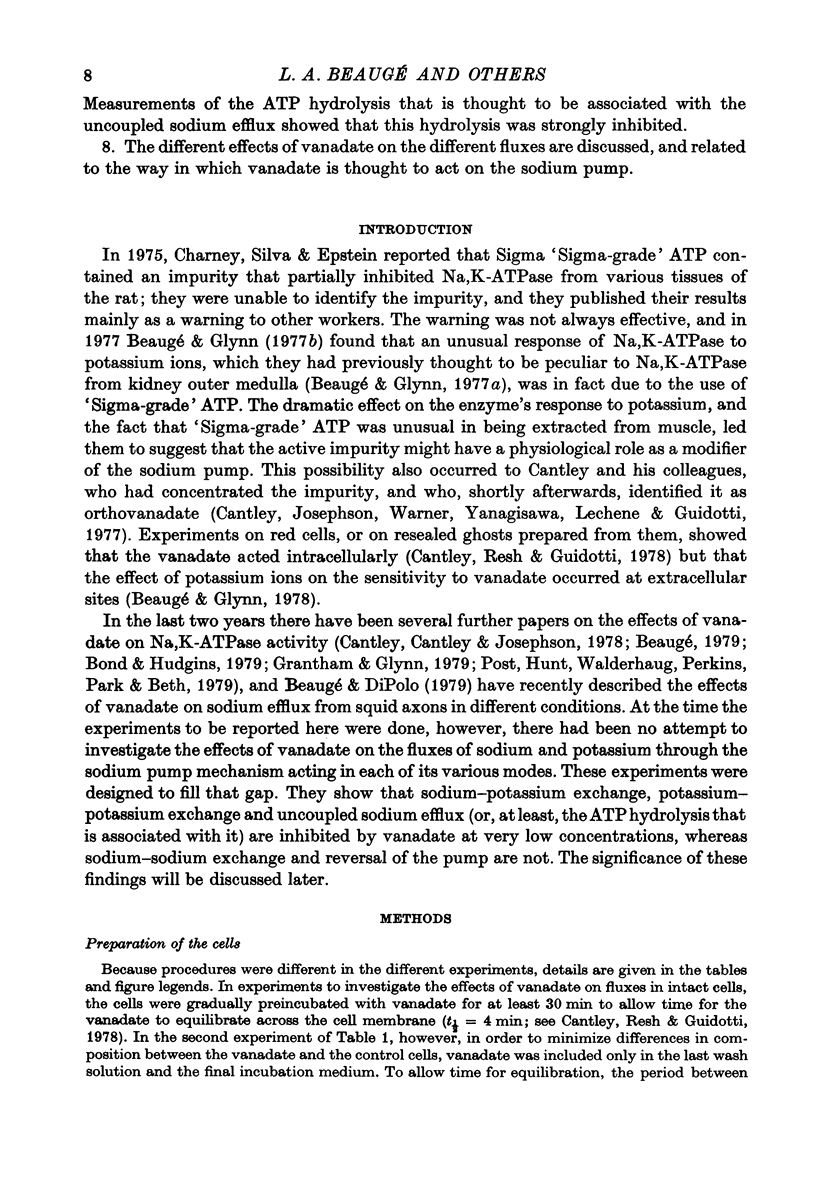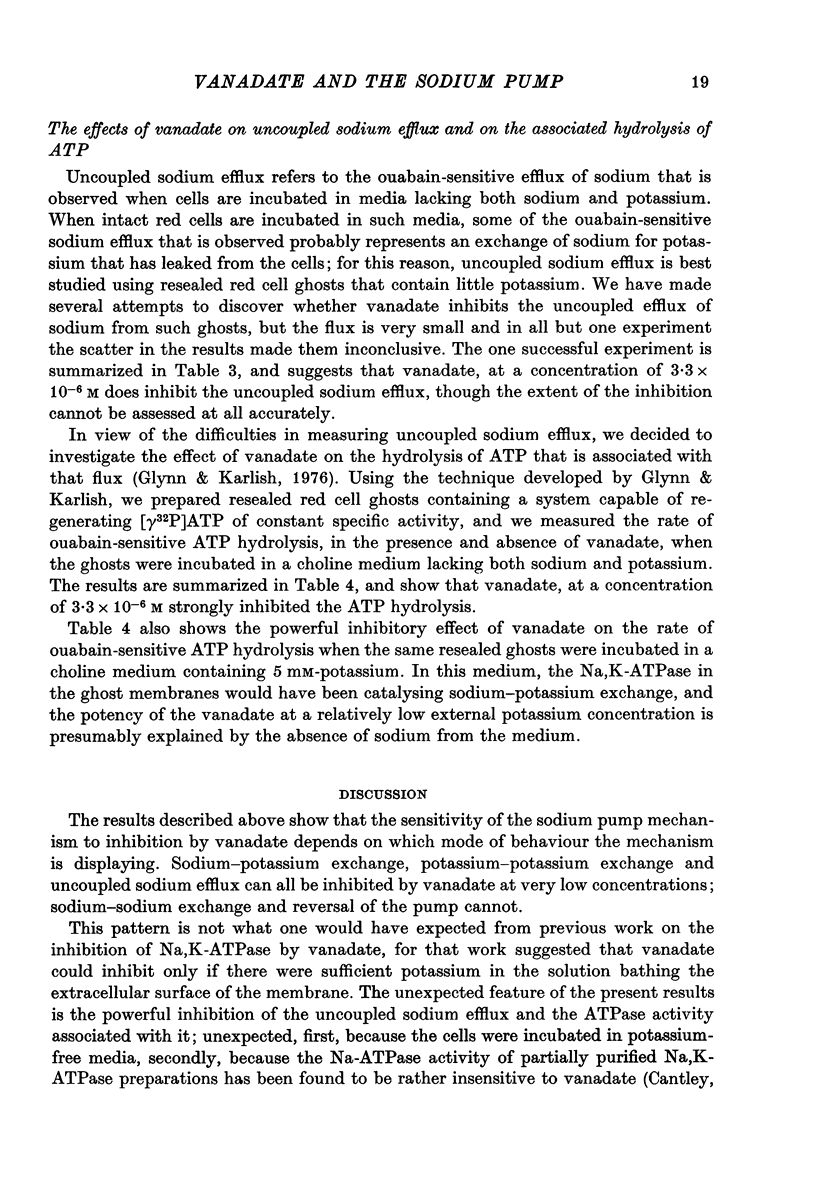Abstract
1. The effects of sodium orthovanadate on the fluxes of sodium and potassium (or rubidium) ions through the sodium pump have been investigated in intact human red cells and in resealed ghosts prepared from them. Sodium—potassium exchange, potassium—potassium exchange, pump reversal, sodium—sodium exchange and uncoupled sodium efflux have each been studied.
2. When intact human red cells were incubated in high-sodium media containing vanadate in low concentrations, inhibition of potassium or rubidium influx was marked only if the potassium or rubidium concentration in the medium was sufficiently high to cause nearly maximal influx in the absence of vanadate. The absence of inhibition at lower potassium or rubidium concentrations cannot be explained by supposing that the onset of inhibition by vanadate is slower in these conditions.
3. Lowering the extracellular sodium concentration, or raising the vanadate concentration, decreased the minimum concentration of extracellular potassium or rubidium at which inhibition by vanadate was detected.
4. Experiments on potassium influx into intact red cells treated with the ionophore A23187 showed that magnesium ions act at intracellular sites to promote inhibition by vanadate.
5. Measurements of potassium efflux from intact red cells incubated in high-sodium media, with or without potassium, showed that potassium—potassium exchange was inhibited by vanadate at low concentrations whereas reversal of the pump was not.
6. Measurements of sodium efflux from intact red cells or resealed ghosts incubated in high-sodium media, with or without potassium, showed that vanadate had little or no effect on sodium—sodium exchange at concentrations at which sodium—potassium exchange was markedly reduced. Much higher concentrations of vanadate did cause partial inhibition of sodium—sodium exchange.
7. Experiments to determine whether vanadate in low concentrations inhibited uncoupled sodium efflux were inconclusive, but suggested that the flux was inhibited. Measurements of the ATP hydrolysis that is thought to be associated with the uncoupled sodium efflux showed that this hydrolysis was strongly inhibited.
8. The different effects of vanadate on the different fluxes are discussed, and related to the way in which vanadate is thought to act on the sodium pump.
Full text
PDF
















Selected References
These references are in PubMed. This may not be the complete list of references from this article.
- Beaugé L. A., Glynn I. M. A modifier of (Na+ + k+) atpase in commercial ATP. Nature. 1977 Jul 28;268(5618):355–356. doi: 10.1038/268355a0. [DOI] [PubMed] [Google Scholar]
- Beaugé L. A., Glynn I. M. Commercial ATP containing traces of vanadate alters the response of (Na+ + K+) ATPase to external potassium. Nature. 1978 Apr 6;272(5653):551–552. doi: 10.1038/272551a0. [DOI] [PubMed] [Google Scholar]
- Beaugé L. A., Glynn I. M. Occlusion of K ions in the unphosphorylated sodium pump. Nature. 1979 Aug 9;280(5722):510–512. doi: 10.1038/280510a0. [DOI] [PubMed] [Google Scholar]
- Beaugé L. A., Glynn I. M. The equilibrium between different conformations of the unphosphorylated sodium pump: effects of ATP and of potassium ions, and their relevance to potassium transport. J Physiol. 1980 Feb;299:367–383. doi: 10.1113/jphysiol.1980.sp013130. [DOI] [PMC free article] [PubMed] [Google Scholar]
- Beaugé L., Dipolo R. Vanadate selectively inhibits the Ko+-activated Na+ efflux in squid axons. Biochim Biophys Acta. 1979 Feb 20;551(1):220–223. doi: 10.1016/0005-2736(79)90367-5. [DOI] [PubMed] [Google Scholar]
- Beaugé L., Glynn I. M. K ions at low concentrations can inhibit the (Na + K)ATPase from the outer medulla of pig kidney [proceedings]. J Physiol. 1977 Feb;265(1):41P–42P. [PubMed] [Google Scholar]
- Bond G. H., Hudgins P. M. Kinetics of inhibition of NaK-ATPase by Mg(2+), K+, and vanadate. Biochemistry. 1979 Jan 23;18(2):325–331. doi: 10.1021/bi00569a015. [DOI] [PubMed] [Google Scholar]
- Cantley L. C., Jr, Cantley L. G., Josephson L. A characterization of vanadate interactions with the (Na,K)-ATPase. Mechanistic and regulatory implications. J Biol Chem. 1978 Oct 25;253(20):7361–7368. [PubMed] [Google Scholar]
- Cantley L. C., Jr, Josephson L., Warner R., Yanagisawa M., Lechene C., Guidotti G. Vanadate is a potent (Na,K)-ATPase inhibitor found in ATP derived from muscle. J Biol Chem. 1977 Nov 10;252(21):7421–7423. [PubMed] [Google Scholar]
- Cantley L. C., Jr, Resh M. D., Guidotti G. Vanadate inhibits the red cell (Na+, K+) ATPase from the cytoplasmic side. Nature. 1978 Apr 6;272(5653):552–554. doi: 10.1038/272552a0. [DOI] [PubMed] [Google Scholar]
- Cavieres J. D., Ellory J. C. Allosteric inhibition of the sodium pump by external sodium. Nature. 1975 May 22;255(5506):338–340. doi: 10.1038/255338a0. [DOI] [PubMed] [Google Scholar]
- Charney A. N., Silva P., Epstein F. H. An in vitro inhibitor of Na-K-ATPase present in an adenosinetriphosphate preparation. J Appl Physiol. 1975 Jul;39(1):156–158. doi: 10.1152/jappl.1975.39.1.156. [DOI] [PubMed] [Google Scholar]
- Flatman P. W., Lew V. L. The magnesium-dependence of sodium:potassium and sodium:sodium exchange mediated by the sodium pump in intact human red cells [proceedings]. J Physiol. 1979 Feb;287:33P–34P. [PubMed] [Google Scholar]
- Flatman P., Lew V. L. Does ionophore A23187 mediate Na transport in the absence of divalent cations? Nature. 1977 Dec 1;270(5636):444–445. doi: 10.1038/270444a0. [DOI] [PubMed] [Google Scholar]
- Garrahan P. J., Glynn I. M. The behaviour of the sodium pump in red cells in the absence of external potassium. J Physiol. 1967 Sep;192(1):159–174. doi: 10.1113/jphysiol.1967.sp008294. [DOI] [PMC free article] [PubMed] [Google Scholar]
- Garrahan P. J., Glynn I. M. The sensitivity of the sodium pump to external sodium. J Physiol. 1967 Sep;192(1):175–188. doi: 10.1113/jphysiol.1967.sp008295. [DOI] [PMC free article] [PubMed] [Google Scholar]
- Glynn I. M., Karlish S. J. ATP hydrolysis associated with an uncoupled sodium flux through the sodium pump: evidence for allosteric effects of intracellular ATP and extracellular sodium. J Physiol. 1976 Apr;256(2):465–496. doi: 10.1113/jphysiol.1976.sp011333. [DOI] [PMC free article] [PubMed] [Google Scholar]
- Glynn I. M., Lew V. L., Lüthi U. Reversal of the potassium entry mechanism in red cells, with and without reversal of the entire pump cycle. J Physiol. 1970 Apr;207(2):371–391. doi: 10.1113/jphysiol.1970.sp009067. [DOI] [PMC free article] [PubMed] [Google Scholar]
- Grantham J. J., Glynn I. M. Renal Na,K-ATPase: determinants of inhibition by vanadium. Am J Physiol. 1979 Jun;236(6):F530–F535. doi: 10.1152/ajprenal.1979.236.6.F530. [DOI] [PubMed] [Google Scholar]
- Hudgins P. M., Bond G. H. (Mg2+ + K+)-dependent inhibition of NaK-ATPase due to a contaminant in equine muscle ATP. Biochem Biophys Res Commun. 1977 Aug 8;77(3):1024–1029. doi: 10.1016/s0006-291x(77)80080-6. [DOI] [PubMed] [Google Scholar]
- Karlish S. J., Beaugé L. A., Glynn I. M. Vanadate inhibits (Na+ + K+)ATPase by blocking a conformational change of the unphosphorylated form. Nature. 1979 Nov 15;282(5736):333–335. doi: 10.1038/282333a0. [DOI] [PubMed] [Google Scholar]
- Karlish S. J., Glynn I. M. An uncoupled efflux of sodium ions from human red cells, probably associated with Na-dependent ATPase activity. Ann N Y Acad Sci. 1974;242(0):461–470. doi: 10.1111/j.1749-6632.1974.tb19110.x. [DOI] [PubMed] [Google Scholar]
- Karlish S. J., Yates D. W., Glynn I. M. Conformational transitions between Na+-bound and K+-bound forms of (Na+ + K+)-ATPase, studied with formycin nucleotides. Biochim Biophys Acta. 1978 Jul 7;525(1):252–264. doi: 10.1016/0005-2744(78)90219-x. [DOI] [PubMed] [Google Scholar]
- Karlish S. J., Yates D. W. Tryptophan fluorescence of (Na+ + K+)-ATPase as a tool for study of the enzyme mechanism. Biochim Biophys Acta. 1978 Nov 10;527(1):115–130. doi: 10.1016/0005-2744(78)90261-9. [DOI] [PubMed] [Google Scholar]
- Lew V. L., Hardy M. A., Jr, Ellory J. C. The uncoupled extrusion of Na+ through the Na+ pump. Biochim Biophys Acta. 1973 Oct 11;323(2):251–266. doi: 10.1016/0005-2736(73)90149-1. [DOI] [PubMed] [Google Scholar]
- Reed P. W., Lardy H. A. A23187: a divalent cation ionophore. J Biol Chem. 1972 Nov 10;247(21):6970–6977. [PubMed] [Google Scholar]
- Sachs J. R. Competitive effects of some cations on active potassium transport in the human red blood cell. J Clin Invest. 1967 Sep;46(9):1433–1441. doi: 10.1172/JCI105635. [DOI] [PMC free article] [PubMed] [Google Scholar]


